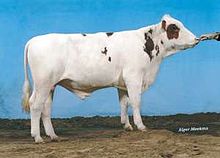
Summary
The Meuse-Rhine-Issel or Meuse-Rhine-Yssel (Dutch: Maas-Rijn-IJssel) is a Dutch breed of dual-purpose cattle, reared both for meat and for milk.[6][7] It falls within the Lowland-Pied group of North European cattle; it is red-pied, and of medium-large size.[8]: 45
 Bull, photograph from circa 1938 | |
| Conservation status | |
|---|---|
| Other names |
|
| Country of origin | Netherlands |
| Use | dairy |
| Traits | |
| Weight |
|
| Height | |
| Coat | red pied, often with little red[5] |
| |

History edit
The Meuse-Rhine-Issel developed principally in two areas of Holland: the eastern part of the province of Noord-Brabant in the southern part of the country, where the rivers Meuse and Rhine flow; and the area of the river IJssel in the east, mainly in Salland and Twente in the province of Overijssel, but extending southwards into the Achterhoek of Gelderland and northwards into the province of Drenthe.[6] It is named for the three rivers.
It was registered in the herd-book of the Nederlands Rundvee Syndicaat from 1874; it was recognised as a breed in 1905, and a separate herd-book was started.[6]
Numbers are in steep decline: in the 1970s there were more than half a million of the cattle, representing approximately a quarter of the total number of dairy cattle in the Netherlands; numbers fell to 31000 in 1999 and to 14000 in 2004.[9]: 142 [10] In 2021 the total population reported to DAD-IS was 9938.[3] Over 925000 doses of semen are kept in cryo-conservation; they represent almost 250 bulls, of which about one-fifth are from before 1980.[7]
In the twentieth century the Meuse-Rhine-Issel was one of the five breeds approved for cross-breeding with the British Dairy Shorthorn, leading to the development of the Blended Red-and-White Shorthorn and the virtual disappearance of the traditional Shorthorn breed.[11]: 16 [4]: 163 The Dutch Improved Red Pied (Dutch: Verbeterd Roodbont Vleesras) is a modern meat breed derived from dual-purpose Meuse-Rhine-Issel stock.[4]: 172 The Brandrood IJsellvee is a modern breed which preserves the old colouring of the Meuse-Rhine-Issel, dark red with little white.[4]: 242
Characteristics edit
The Meuse-Rhine-Issel falls within the Lowland-Pied group of North European cattle; it is red-pied, and of medium-large size.[8]: 45
References edit
- ^ Barbara Rischkowsky, Dafydd Pilling (editors) (2007). List of breeds documented in the Global Databank for Animal Genetic Resources, annex to The State of the World's Animal Genetic Resources for Food and Agriculture. Rome: Commission on Genetic Resources for Food and Agriculture, Food and Agriculture Organization of the United Nations. ISBN 9789251057629. Archived 23 June 2020.
- ^ [s.n.] (26 June 2020). Rassenlijst Nederlandse landbouwhuisdierrassen (in Dutch). Wageningen: Centrum voor Genetische Bronnen Nederland. Accessed May 2022.
- ^ a b Breed data sheet: Maas-Rijn-IJssel / Netherlands (Cattle). Domestic Animal Diversity Information System of the Food and Agriculture Organization of the United Nations. Accessed May 2022.
- ^ a b c d e f Valerie Porter, Lawrence Alderson, Stephen J.G. Hall, D. Phillip Sponenberg (2016). Mason's World Encyclopedia of Livestock Breeds and Breeding (sixth edition). Wallingford: CABI. ISBN 9781780647944.
- ^ Maas-Rijn-IJsselvee (MRIJ) (in Dutch). Wageningen: Stichting Zeldzame Huisdierrassen. Accessed May 2022.
- ^ a b c Yvette de Haas, Rita Hoving-Bolink, Myrthe Maurice-van Eijndhoven, Debbie Bohte-Wilhelmus, Henk Sulkers, Sipke-Joost Hiemstra (2009). MRIJ breed assessment. Wageningen: Centre for Genetic Resources, the Netherlands = Centrum voor Genetische Bronnen Nederland. Accessed May 2022.
- ^ a b Henri Woelders, Ina Hulsegge, Henk Sulkers, Rita Hoving, Sipke-Joost Hiemstra (2009). Cryoconservation of cattle breeds in The Netherlands. Wageningen: Centre for Genetic Resources, the Netherlands = Centrum voor Genetische Bronnen Nederland. Accessed May 2022.
- ^ a b D.S. Buchanan and J.A. Lenstra (2015). Breeds of Cattle. In: Dorian J. Garrick, Anatoly Ruvinsky (editors) (2015). The Genetics of Cattle, second edition. Wallingford: CABI. ISBN 9781780642215, pages 33–66.
- ^ Sipke Joost Hiemstra, Yvette de Haas, Asko Mäki-Tanila, Gustavo Gandini (editors) (2010). Local cattle breeds in Europe: Development of policies and strategies for self-sustaining breeds. Wageningen Academic. ISBN 9789086866977. doi:10.3921/9789086866977. Accessed May 2022.
- ^ Meuse-Rhine-Yssel cattle (MRY). EuReCa. Accessed May 2022.
- ^ Marleen Felius (1995). Cattle Breeds: An Encyclopedia. Doetinchem, Netherlands: Misset. ISBN 9789054390176.


